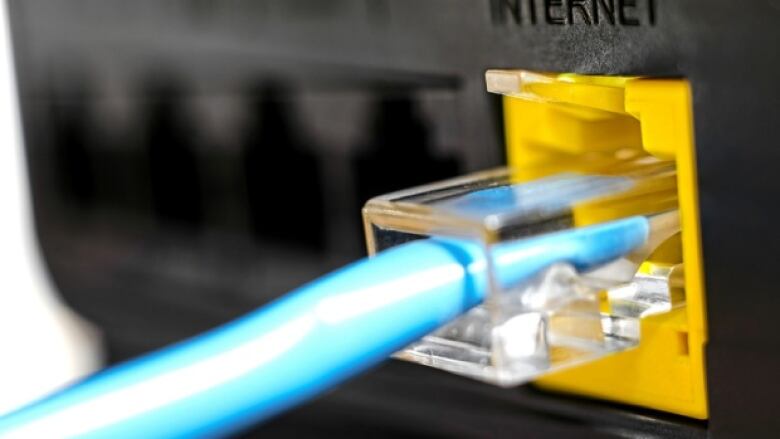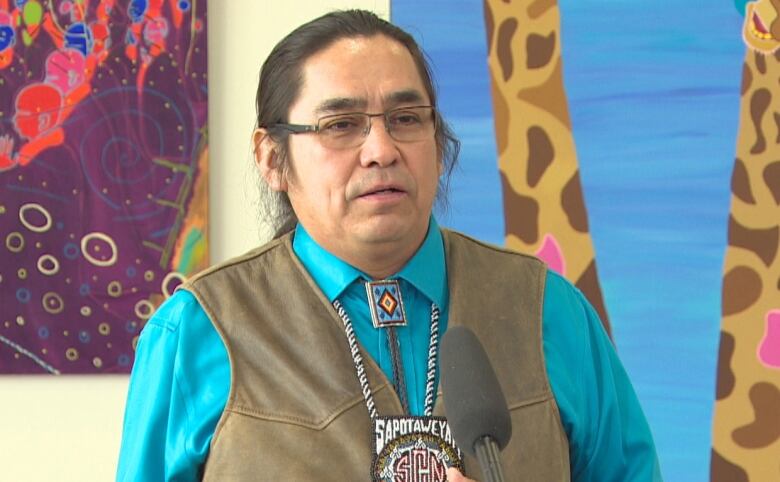'A good start': High-speed internet to reach 112 rural, remote Manitoba communities
$83.9M investment will unlock faster connection for 48 First Nations, feds say

Nearly 25,000 homes with spotty internetin rural towns and remote Manitoba First Nations mayunlock speedier connections by next year aspart of a joint$83.9-million infrastructure pledge from the Manitoba and federal governments.
"This is a very good day," Sheila North,grand chief ofManitoba Keewatinowi Okimakanak, said Tuesday."It's still a long way out, but it's a good start."
The plan will improve high-speed internet access in 112 remote Manitoba communities with help from private service providers, federal Innovation Minister Navdeep Bains announced Tuesday in Winnipeg.
"We believe that in this new digital era it's really criticalnot only for education for young people, for businesses to succeed in their communities and internationally, but also very important for health care," Bains said.
Hesaid the improvements will help underserved residents stay better connected and be a boon to education and employment in remote parts of the province.
Forty-eight of the communities to receive improvements are First Nations, 21 of which don't haveyear-round road access, the federal government said in a news release.
The federal government is committing $43.7 million through its previously announced $500-million Connect to Innovate program, along with $3.5 million from Indigenous Services Canada. The bulk of that ($38.5 million) will be used to bring fibre-optic infrastructure to 19,000 homes, while another $5.17 million is earmarked for connecting 4,150 underserved homes that currently have very sparse service.
Manitoba is committing $20 million, and $16.7 million is coming from other contributors, including$7.5 million from service providers Clear Sky Communications andRFNOW Inc.
First Nations-owned Clear Sky and three other service providers stand to receive more than half of the funding:Clear Sky Communications ($33.5 million), Valley Fibre ($10.3 million), BellMTS($2.7 million) and Broadband Communications North($673,000).
The project is expected to get underway immediately and be completed late in 2019,Bainssaid.
First Nation partnerships
Indigenous Services Minister Jane Philpottsaid the planned upgrades include partnerships with some First Nations that will own, control or operate their local broadband networks. One of those partners isSapotaweyakCree Nation, about 400 kilometres northwest of Winnipeg.
"This is a remarkable day for us and for Manitoba First Nations,"SapotaweyakChief NelsonGenaille, co-chair of Clear Sky Communications, said in a statement.

Clear Sky willreceive $33.5 million to deliverinternetconnection speeds that are equal to those in southern Manitoba, the federal government said.
That includes a $20-million in-kind contribution from the Manitoba government. As part of the agreement, Clear Skywill tap into Manitoba Hydro's fibre optic cable network.
"There is enormous potential in northern Manitoba," Premier Brian Pallister said in a statement. "Developing that potential is a priority of our provincial government, and to do that we need the tools to maximize our opportunities."
'Mercy of the environment'
Genaille said the patchwork of internetservices in some remote communitiespresents challenges unlike those seen in more accessible areas of Manitoba. Sapotaweyakdoesn't have cellphone serviceor access to a local 911 emergency phone service, he said.
"There's manydeaths that happen where if we had 911 we could've saved a life," Genaillesaid.
Harsh or stormy weather also playsa large role in determining internetconnection, he said.
"You're at the mercy of the environment," he said. "[The connection] just basically stops."
Each of the 62 First Nation members ofthe Assembly of Manitoba Chiefs is an equal owner of Clear Sky.Once the new infrastructure is in place,Genaille said each AMC memberwill have an opportunity to form their own business to provide internetservices to locals andfederal agencies operating on reserves such as RCMP,Health Canada and Indigenous and Northern Affairs.
Theability to simply do email, for example,most of us take it for granted- TheodoreBaschak
Genaille said a K-12 school that was built in his community a few years ago was outfitted with touch-screensmart boards in classrooms, but they'venever fully reached their educational potential due tointermittent internet connections.Genaille said the technology allows ateacher in one location to instruct a class in anotherhence its appeal to remote communities like his.
"But because of connectivity, Wi-Fi is fragmented and you weren't able to get a good, clear discussion," he said, "and you would see it in slow motion."
Shoddy internet has also meant some young students have had to seek certain courses outside the community, he said.
Genaille also hopes that with a few side projects, the new changes will also makecellphone reception a reality inSapotaweyakand others that still don't have it.
'Work grinds to a halt'
TheodoreBaschaksaid he is optimistic remote First Nations will soon have fewer barriers to quality internet.
Hevisited nearly every Manitoba First Nation in his former capacity asnetwork services director forBCN, one of the companies receiving some of the government funds.

"As I traveled around and experienced the internet available to people in various locations around the communities I visited, it became obvious why phone was so much more popular than email,"Baschak, now a network architect forDaemonDefenseSystems, wrote in an email.
"I think that if you don't have reliableinternet, you're missing out on part of what is commonly considered everyday modern life to many people, especially my generation and younger."
Baschaksaid service varies widely between different remote First Nations largely because of thedated satellite service delivery systems in use.
"Theability to simply do email, for example,most of us take it for granted," he wrote.
"If theinternetis out for a few minutes it's an inconvenience;if it's out for an afternoon, work grinds to a halt;and if it's out for weeks it could seriously affect a business.
"If everyday email is a half-day or whole-day task, suddenlythat makes it that much more difficult to get anything else done. It's no longer a background task that you can get to, it's a foreground task you need to monitor to get the page loaded."
Corrections
- Based on information from the Manitoba government, a previous version of this story stated the Winnipeg Foundation was contributing $1 million in funds to the rural and remote internet projects. In fact, a Winnipeg Foundation spokesperson says that is not the case.Jan 10, 2018 1:00 PM CT













_(720p).jpg)


 OFFICIAL HD MUSIC VIDEO.jpg)
.jpg)



























































































